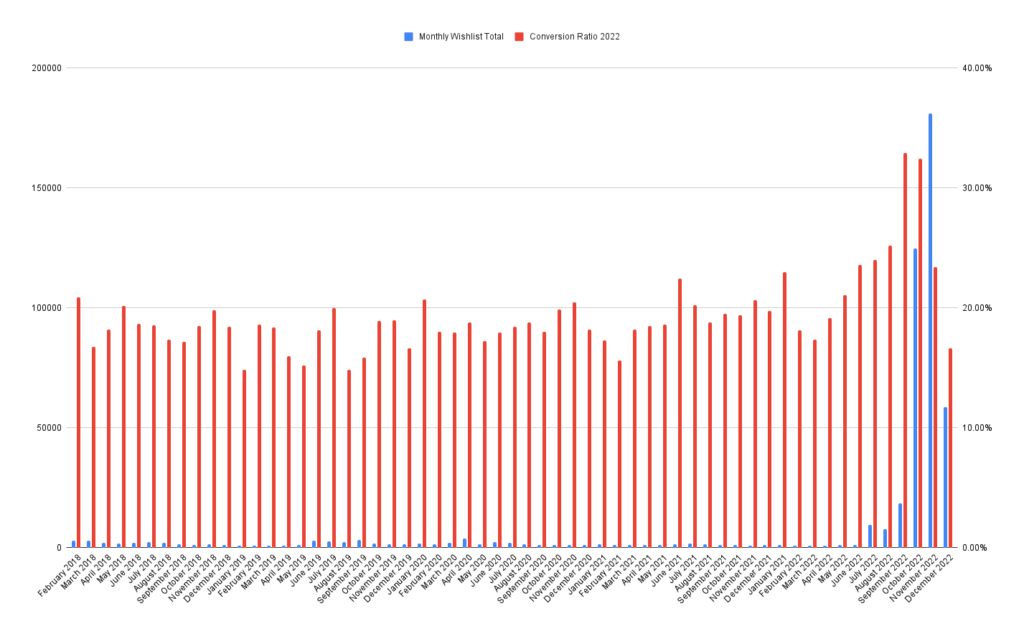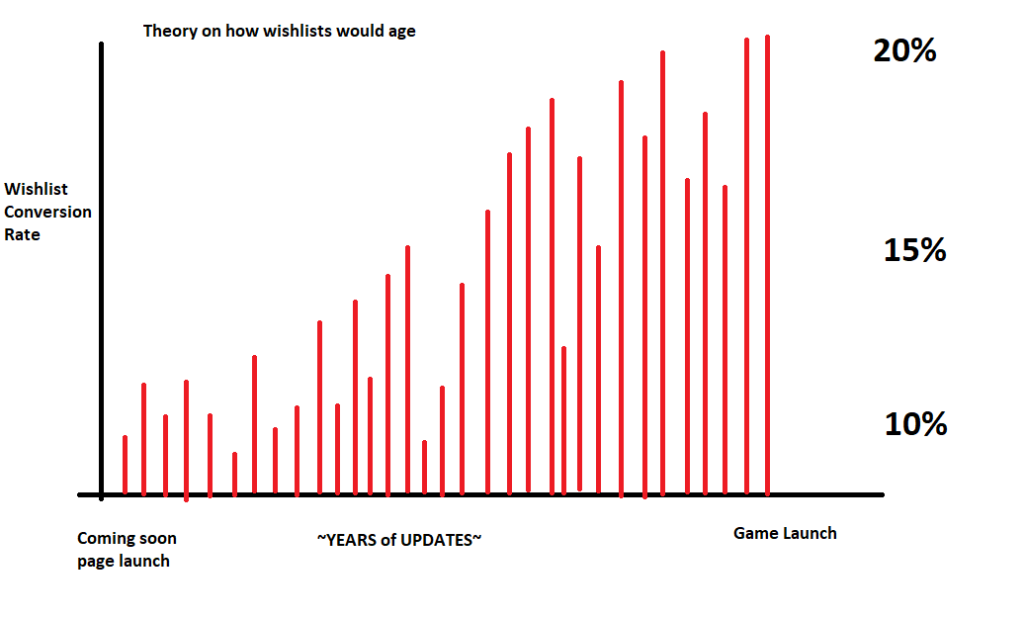
I recommend that developers post their Steam page as soon as they have these 3 things:
- They know the genre and basic gameplay loop.
- Their art style is decided (but not at final fidelity) and have 3 environments that they can include in screenshots (to indicate variety and that the game is not an asset flip).
- They have professional-quality marketing assets: a short intro trailer that shows gameplay and an attractive capsule.
It is important to have as much time as possible to build your steam community and collect wishlists, even though your game might be years away from release,
One of the most common arguments against my “get it up ASAP” recommendation is that the people who wishlisted your game years ago when you first posted your Steam coming soon page will grow tired of you and not buy your game. It is as if their relationship to your game is the fading flame of a long marriage.

In today’s blog I talk to Walt Destler who launched the phenomenally successful spaceship crafting game Cosmoteer at the end of 2022 after 4.5 YEARS of marketing it on Steam. It sold over 281k units at $20.00 (with a 10% launch discount).
Cosmoteer’s launch is a perfect test case to answer whether wishlists can “go stale.” Did his early fans “get tired of his game?” Were they tired of him?
The short answer: no
Walt sent me Cosmoteer’s lifetime cohort conversion and wishlist data (available in Steamworks) to calculate the conversion rate of every wish list based on its age. For more information on calculating cohort conversion for released games, check out my blog post on ZERO Sievert.
Each red bar in the following chart is the conversion rate (right axis) and the date at the bottom is when they added the game to their wishlist. The blue bars are the wishlists chart per month.

As you can see from this graph, the wishlist conversion rate oscillated between 21% and 15% at a noisy but consistent rate. There was no indication that the older wishlists converted worse.
If wishlists did “go stale” you would expect the graph to look something like this mspaint drawing I threw together last night:

But they don’t! The conversion rate on month 1 is about the same as the wishlists that are collected at month 50!
There is a slight increase in conversion rate in the last 3 months of the release, but that does not mean the earlier wishlists are trash.
Why the increase? My hunch is that those are from Steam Next Fest and a bunch of Streamers playing it. You can see that the number of wishlists earned go up a lot right near release. As I mentioned in ZERO Sievert writeup, streamers and Steam festivals increase the conversion ratio. I think this is because they serve as an endorsement. And because Cosmoteer had a bunch of promotional activity right at the end, the conversion rate went up.
Other interesting stats:
- Release date: October 24, 2022
- 1st week sales: 74k
- Launch wishlists: ~144k
- total sales: 281k (as of February 2023)
- Country that is the biggest customer: Germany (31%), USA is #2 (29% but is catching up fast )
- Walt’s experience before working and publishing Cosmoteer? Full time developer at a F2P mobile games studio named Rumble Entertainment (Side note: the number of successful Steam developers that come from mobile F2P is a very underappreciated fact).
So how did Cosmoteer do this?
First, as always, it is the game. Cosmoteer is in the perfect genre and theme that Steam shoppers just can’t get enough of: strategic, sandboxy, endlessly replayable, no story other than lore, it set in space (they love space), and infinitely deep.
Just look at the playtime data for Cosmoteer demo: 1 hour and 53 minutes!

Walt’s first Cosmoteer prototype was built in January 2011 (it was originally called StarWright) You can see his earliest dev logs here. He worked on it for years posting about it on sites like Tigsource. You can see the original thread here.
Then he put a completely free, early build of his game on itch.io (link to the game) and his personal website cosmoteer.net. He didn’t even have a Steam page yet.
Then, in 2017 after posting the game to itch.io, streamers found the free demo and expanded his small community a lot. Walt estimates that combined, those videos had over 7,000,000 views and playtime leveled out to 1K-2K players per day.
“Not having the steam page up when that happened is probably my #1 regret”
Walt Destler
Here are some of the biggest videos from 2017
- Aavak (63K views)
- Nookrium (18K views)
- JoshFTL (80K views)
- EnterElysium (83K views)
- ScrapMan (119K views)
- Blitz (458K views)
Steam coming soon page launch 2018
On February 8th, 2018 Walt finally published his Steam coming soon page. Within the first 2 weeks he earned over 2000 wishlists. How did he do this?
“At the time I had my Discord (a couple thousand people maybe?) and I think my email newsletter as well which I definitely notified. I also put an in-game news popup encouraging people to wishlist. I’m sure I also did twitter/facebook posts but barely anyone follows me there (even now) so that probably didn’t do much.”
Walt Destler
In the first few months he was earning on average 462 wishlists per week despite no active promotion. He suspects it was the YouTube videos and the free demos that provided this traffic.
Ongoing open development
The demo was still up for free and on July 5th, 2019 Walt made the demo available on Steam.
But this wasn’t a demo. This was the FULL game available for Free. Here is how Walt describes it on his blog:
“Even though it’s called a “Demo”, it’s really the full version of Cosmoteer and is not limited in any way. Making it a demo was simply the best option for allowing the game to be downloaded on Steam without giving away the paid version for free. Please note that the demo will likely be removed before Cosmoteer launches as a paid game.” (note that Walt kept a demo up despite his promise to remove it.)
Walt Destler
About 9 months later Walt split development between classic Cosmoteer and New Cosmoteer. The new version had “overhauled main career mode, mining/salvaging, completely new graphics, co-op multiplayer (classic has PvP multiplayer but no co-op in the career mode), a handful of new ship weapons/modules, and lots of other little improvements”
Other promotional beats that worked well for Walt at this stage were
A hacker news post (~1289 wishlists)
A PC Gamers article (~455 wishlists)
Splattercat (~11,155 wishlists)
Steam Next Fest
Cosmoteer managed to get into 2 Steam Next Fests due to the changing rules that Valve put in place at the start of these festivals.
The first entry was in the first Steam Festival in June 2020 and only earned him 716 wishlists.
After that first Next Fest, Valve clamped down on how many you could appear in. So Cosmoteer smartly opted to wait until the last one before launch: The October 2022 Steam Next Fest. Cosmoteer entered the festival with 108,115 total wishlists and because of the festival’s new “Most Wishlisted” tab, the game was almost permanently pinned to the front page. The game earned 30,286 net wishlists during the week-long event.
Summary
For most games, when a developer tells me they have been working on the same game for 11 years, I get really nervous. That is a big risk on a single title. Most games do not make back their development costs. However, Walt was able to make the long development time work because Cosmoteer had proven itself to be a game that people really wanted.
This validation wasn’t just a bunch of friends saying “oh looks fun!” He had the hard core numbers to back it up:
- His early itch.io free demo consistently had over 1000 concurrent players.
- Youtubers were playing his game without him even sending it to them and it earned him over 7,000,000 views.
Cosmoteer’s Steam page stats also matched my benchmarks for a diamond tier game (💎) or at least a top tier gold game (🥇):
- The first two weeks earned him over 2000 wishlists (Benchmark: 🥇=1200. 💎=7000 wishlists)
- Resting wishlist rate for 7 days was typically 400+ (Benchmark: 🥇=100 – 700, 💎=300 – 3000)
- Demo median playtime was 113 minutes (Benchmark: 💎 65 minutes)
- At launch he had 144,000 wishlists (Benchmark 🥇=30,000, 💎=150,000)
As you can see, there were many confirming stats that he had something people really wanted. He had validated the game in the marketplace and therefore de-risked having an extended development period. We can also confirm that there was no penalty for having a Steam page up for almost 5 years.
Now, play once narrative games do not have this luxury. This only works for the replayable sandbox games. But that is also whey indies are most successful when they make replayable games.
When you have a game that the market wants true fans will do anything to get it. They will wait years for it. They will work around not having a story mode. Even if you put the game up 100% free for almost 4 years, new people will still find and support you. As an indie, our biggest problem is people not noticing you and there is no way you can show your game to everyone. So don’t be coy. Don’t try to hide and slowly reveal gameplay. The long dev time didn’t make fans “tired of the game.”